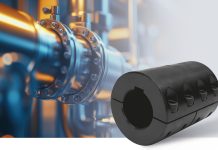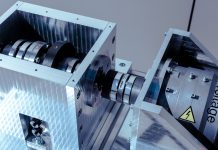Thin-section ball bearings have a much subtler cross section than standard bearings’ with the same diameter. Such characteristic makes them more sensitive to the tolerances of shaft and housing. An appropriate assembly is important to assure the adequate bearing operation.
Rob Roos
Thin-section ball bearings have a much subtler cross section than standard bearings’ with the same diameter. Such characteristic makes them more sensitive to the tolerances of shaft and housing. An adequate assembly is important to assure the bearing operates appropriately.
Various factors must be taken into account in the assembling of a bearing. They include the type of bearing and its orientation, the direction and the amount of applied loads, the maximum gap inside the bearing, the maximum friction torque permitted, the assembling tolerances of shaft and housing, the operational temperature and which of the two rings rotate.
Radial bearings (C-type)
Radial bearings are typically used when the loads applied are mainly radial. If two bearings are mounted on the extremities of a long shaft, one of the two bearings should be free in axial direction (fig. 1). This is done to avoid that the thermal expansion of the shaft or of the housing causes an axial thrust on a radial bearing.
Four-point contact bearings (X-type)
Four-point contact bearings are used wherever axial loads are present or a combination of radial, axial loads and tilting moments (fig. 2). If two bearings are mounted on the extremities of a long shaft, one of the two bearings should be radial (C-type) and should be free in axial direction, as illustrated in figure 1. It is not generally recommended to use two four-point contact bearings on the same shaft.
A single four-point contact bearing can absorb an axial load in both directions. It can also absorb radial loads and tilting moments. However, this type of bearing has generally a higher friction than the one generated by a radial bearing (C-type) or by an angular contact bearing (A-type) with the same sizes.
It is worth noticing that, if radial and four-point contact bearings are used, it is recommended to follow the manufacturer’s recommendations concerning the tolerances of shaft and housing, interference or gap. Using the recommended tolerances, you assure that bearings are not preloaded after the installation, because in such case this might affect duration and performance. Recommended couplings are valid only for bearings with standard gap. They are valid for the applications that operate at environmental temperature or with steel shafts and housings. If different materials are used, assembling tolerances will change according to the operational temperature. If using other materials, apart from steel, assembly tolerances are not varied, a preload might occur with a consequent excessive friction torque. When bearings are supplied with diameter preload, a slight backlash is recommended for both shaft and housing. For friction- and high-speed sensitive applications, pairs of angular-contact bearings are generally used instead of a single four-point contact bearing.
[su_box title=”About Kaydon “]Kaydon Bearings, a company of SKF Group, is world leader in the production of standard and on-design thin-section bearings, in addition to sleeves and bearings integrated for industrial applications and processes. Kaydon supplies customized products, based on specific requirements and performances, to different typologies of customers and sectors, like industrial, aerospace, medical and electronic equipment, renewable energies and after-market. The company, which ideated the thin-section bearing in 1943, is a division of Kaydon Corporation, with headquarters in Muskegon, Michigan, USA. In Italy, Kaydon bearings are distributed by Magi Srl, Milan. [/su_box]
Angular-contact bearings (A-type)
Angular-contact bearings can absorb an axial load (thrust) in a single direction and for this reason, when used, they are almost always used in combination. They can be used both in back-to-back configuration (DB), and face-to-face (DF) (figg. 3 and 4). Combined angular-contact bearings are generally used with a certain axial preload to remove the whole backlash and to increase stiffness. Angular -contact bearings can be purchased individually or in pairs. If bought singularly, the user must register the preload during the installation. If purchased in combination, the preload is executed in the factory.
If angular-contact bearings are bought in pairs (in this case they are called «duplex pair»), inner and outer rings must be fixed as illustrated in figure 5. For the bearings with an axial preload, a slight gap between the bearing and both the shaft and the bearing is advisable. If a third bearing is used on the opposite extremity of a long shaft, it should be either a single radial pair or a face-to-face pair (DF). It is also expected to be able to move in axial direction (fig. 5). In general, two pairs of back-to-back bearings (DB) are not used on the same shaft.
Generally recommendations
Radial and four-point contact bearings that use ball-type «snap-over» or «crown» separators should be mounted with the solid part of the separator oriented to the top and pocket openings facing the bottom (if the shaft orientation is within 45° with regard to the vertical axis). These bearings are typically marked by a «UP» arrow (facing the top) to show the ideal orientation (fig. 6). There is not instead a preferential orientation for horizontal shafts.
Single-row angular-contact bearings (A-type) can only absorb axial loads (thrust) in one direction. The outer diameter of these bearings is marked by an arrow and by the word «THRUST» to indicate the direction in which the thrust load can be applied outside (fig. 7).
If these bearings are mounted in back-to-back configuration (DB), arrows should be oriented to the opposite direction each other. In a face-to face configuration (DF), arrows should face each other.
Angular-contact bearings bought in pairs (duplex) will be marked by a «V» in inner and outer surfaces of the rings of both bearings. During the installation, these «V» marks should be aligned each other. (For vertical shafts, it does not matter whether the «V» faces the top or the bottom). «V» marks are positioned in the point of highest eccentricity of rings and must coincide with the point of minimum eccentricity of shaft and housing, to reduce the eccentricity of the whole (fig. 8).
Tolerances of shaft and housing
As their cross sections are much thinner than the ones of standard bearings with the same diameter, thin-section ball bearings are very sensitive to the geometries of shaft and housing. After the installation, the bearing tends to take the shape of the shaft and of the housing. Consequently, the roundness of shaft and housing is very important, like the planarity of bearings’ seats.
For this reason, the planarity tolerance (A and D characteristics of figure 9) of bearing seats should be the same as the axial eccentricity of the combined bearing’s ring. The planarity tolerance (B and C characteristics in figure 9) for the shaft and the housing should be the same of the radial eccentricity of the mounted bearing’s ring. Both the shaft and the housing should have a shallow chamfer on rings to facilitate the assembly. The radii of the junction bevel at the angles of bearings’ seats are required to have smaller sizes than the bearing chamfer’s. Wherever interference assemblies are used, it is possible to heat or to cool the bearing to facilitate its assembling. It is recommended to proceed then to the tightening only when all components are at environmental temperature.
If it is necessary to use an interference assembly, uniform pressure must be exerted on the entire surface of the bearing. Exerting a pressure on the ring with interference assembly will be anyway needed. If, for instance, an interference assembly is used between bearing and shaft, it is necessary to apply a pressure on the inner ring and not on the outer one. Warning: do not exert a cross pressure because this might damage the bearing.
Preload
The optimal preload for any bearing depends on the application type. When the preload increases, the deflection under load decreases (fig. 10) whereas the bearing stiffness and its natural frequency rise. However, the preload increase causes a higher friction torque, too. There are some instruments, like the free Kaydon Reali-Design® software that can be used to calculate the entity of the deflection under a certain load, applied according to different preload levels. This instrument can be also used to calculate the quantity of optimal preload for every application type.
Clamping rings
It is advisable to use clamping flanges or plates on all bearings rather than exclusively turning to an interference assembly to tighten the bearing. It is recommended to superimpose clamping flanges, where possible, to form a labyrinth shield, as illustrated in figure 11. This contributes in keeping the lubricant inside the bearing, leaving contamination outside. For the bearings used in harsh environments, it is recommended to use external seals. To provide a uniform clamping torque, it is preferable to use a bigger number of small-size screws for the tightening instead of few bigger-size screws, in order to distribute the clamping force uniformly on the entire circumference. Clamping elements should be tightened according to a «star» model to distribute the clamping torque uniformly.
Lubrication
Open bearings are delivered with a conservation oil that does not perform the function of lubricating oil. Before the installation, it is necessary to clean the bearings, which will be successively lubricated with a suitable oil or grease for expected loads, speeds, temperatures and environment.
Shielded bearings are lubricated in the factory with a general-purpose grease. Alternative lubricants are available on demand.
Conclusions
An appropriate assembly is important to assure the optimal performance of thin-section ball bearings. The use of adequate bearings, orientations, assembly tolerances recommended and the correct geometries of shaft and housing will assure the full operation performance of the bearing.













